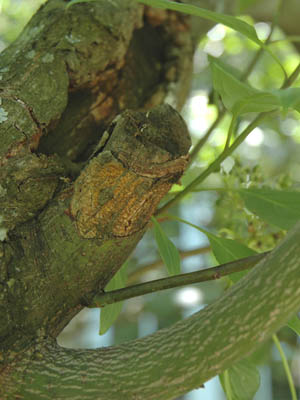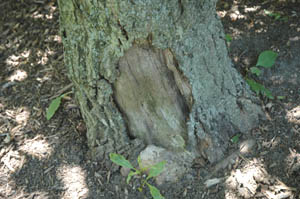Pagoda Dogwood Decline | |
|---|---|
| May 22, 2007 | |
|
The pagoda dogwood (Cornus alternifolia) is a beautiful tree with nice horizontal branching and small tree stature. It does not seem to have as many disease problems as we see with flowering dogwood (Cornus florida) and seems to have better resistance to the potentially lethal Discula anthracnose. Unfortunately, I have been watching my 25-year-old pagoda dogwood decline over the last 5 years. It has trunk cankers, stem cankers, and wilts easily when conditions are dry. The images show the trunk and stem cankers on that tree.   Pagoda dogwoods are very susceptible to a canker disease called Cryptodiaporthe. Some of my southern colleagues have reported that Pagoda dogwoods die after about 20 years of growth because of infection by Cryptodiaporthe canker. Most of us know that canker fungi often infect a plant following stress. That is most likely the case with this disease as well. In the case of my tree, the only stress I can detect is deep planting. There may well be girdling roots belowground. The tree is in a protected location and is watered during drought. Pagoda dogwoods grow best in cool, shady areas and prefer moist, acidic, well-drained soil. They are known to be very drought sensitive and decline when grown in hot, dry sites. If you have a pagoda dogwood growing in a protected, shady spot, be sure to water it in periods of drought. If the tree is left to fend for itself, Cryptodiaporthe canker will likely infect and kill it. Cryptodiaporthe canker is also known as golden canker, from the color of affected branches. Look for stem dieback with cankers at the base of affected branches. Prune to remove cankered wood, cutting 4 to 6 inches below affected areas. Water the tree in periods of drought and try mulching over the root system to provide a more even temperature for the root system and to keep weed trimmers away. Mulch also helps retain moisture. For more information about this disease specifically, refer to the Web site http://www.uwex.edu/ces/wihort/gardenfacts/X1125.pdf. Cankers in general are discussed in Report on Plant Disease, no. 636, “Canker and Dieback Diseases of Woody Plants,” available on the University of Illinois site at http://www.ag.uiuc.edu/~vista/horticul.htm. |